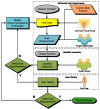Human centred design considerations for connected health devices for the older adult
- PMID: 25563225
- PMCID: PMC4263975
- DOI: 10.3390/jpm4020245
Human centred design considerations for connected health devices for the older adult
Abstract
Connected health devices are generally designed for unsupervised use, by non-healthcare professionals, facilitating independent control of the individuals own healthcare. Older adults are major users of such devices and are a population significantly increasing in size. This group presents challenges due to the wide spectrum of capabilities and attitudes towards technology. The fit between capabilities of the user and demands of the device can be optimised in a process called Human Centred Design. Here we review examples of some connected health devices chosen by random selection, assess older adult known capabilities and attitudes and finally make analytical recommendations for design approaches and design specifications.
Figures






Similar articles
-
What matters to older adults? Exploring person-centred care during and after transitions between hospital and home.J Clin Nurs. 2022 Mar;31(5-6):569-581. doi: 10.1111/jocn.15914. Epub 2021 Jun 11. J Clin Nurs. 2022. PMID: 34117673
-
User-centred health design: reflections on D4D's experiences and challenges.J Med Eng Technol. 2014;39(7):395-403. doi: 10.3109/03091902.2015.1088086. J Med Eng Technol. 2014. PMID: 26453037
-
Nursing students' attitudes towards the use of digital technology in the healthcare of older adults- a cross-sectional study in Norway and Sweden.BMC Nurs. 2023 Nov 14;22(1):428. doi: 10.1186/s12912-023-01600-6. BMC Nurs. 2023. PMID: 37964266 Free PMC article.
-
"I think I could have designed it better, but I didn't think that it was my place": a critical review of home modification practices from the perspectives of health and of design.Disabil Rehabil Assist Technol. 2020 Oct;15(7):781-788. doi: 10.1080/17483107.2020.1749896. Epub 2020 Apr 10. Disabil Rehabil Assist Technol. 2020. PMID: 32275166 Review.
-
The impact of ageing simulation education on healthcare professionals to promote person-centred care towards older people: A literature review.Nurse Educ Pract. 2021 May;53:103077. doi: 10.1016/j.nepr.2021.103077. Epub 2021 May 7. Nurse Educ Pract. 2021. PMID: 33991966 Review.
Cited by
-
Enhancing Home Health Mobile Phone App Usability Through General Smartphone Training: Usability and Learnability Case Study.JMIR Hum Factors. 2018 Apr 26;5(2):e18. doi: 10.2196/humanfactors.7718. JMIR Hum Factors. 2018. PMID: 29699969 Free PMC article.
-
Integrating Evidence From Systematic Reviews, Qualitative Research, and Expert Knowledge Using Co-Design Techniques to Develop a Web-Based Intervention for People in the Retirement Transition.J Med Internet Res. 2016 Aug 3;18(8):e210. doi: 10.2196/jmir.5790. J Med Internet Res. 2016. PMID: 27489143 Free PMC article. Review.
-
Human-Centered Design of Mobile Health Apps for Older Adults: Systematic Review and Narrative Synthesis.JMIR Mhealth Uhealth. 2022 Jan 14;10(1):e29512. doi: 10.2196/29512. JMIR Mhealth Uhealth. 2022. PMID: 35029535 Free PMC article.
-
The Extent and Coverage of Current Knowledge of Connected Health: Systematic Mapping Study.J Med Internet Res. 2019 Sep 25;21(9):e14394. doi: 10.2196/14394. J Med Internet Res. 2019. PMID: 31573915 Free PMC article. Review.
-
A Scoping Review of the Conceptual Differentiation of Technology for Healthy Aging.Gerontologist. 2021 Sep 13;61(7):e345-e369. doi: 10.1093/geront/gnaa051. Gerontologist. 2021. PMID: 32725147 Free PMC article.
References
-
- Rubin J., Chisnell D. Handbook of Usability Testing: How to Plan, Design, and Conduct Effective Tests. John Wiley & Sons; Hoboken, NJ, USA: 2008.
-
- Gould J.D., Lewis C. Designing for usability: Key principles and what designers think. Commun. ACM. 1985;28:300–311. doi: 10.1145/3166.3170. - DOI
-
- International Organization for Standardization . ISO 9241SO10:2010—Ergonomics of human-system interaction—Part 210: Human-Centred Design for Interactive Systems. ISO; Geneva, Switzerland: 2010.
-
- International Organization for Standardization . ISO 9241SO1: Guidance on Usability (1998) ISO; Geneva, Switzerland: 1998.
-
- AAMI/American National Standard . ANSI/AAMI HE75:2009—Human Factors Engineering—Design of Medical Devices. AAMI; Arlington, VA, USA: 2010.
Publication types
LinkOut - more resources
Full Text Sources
Other Literature Sources

